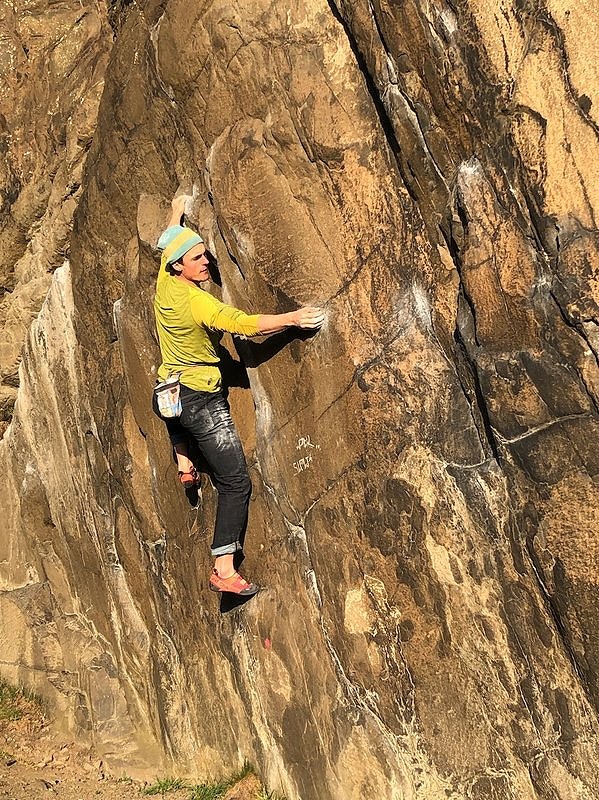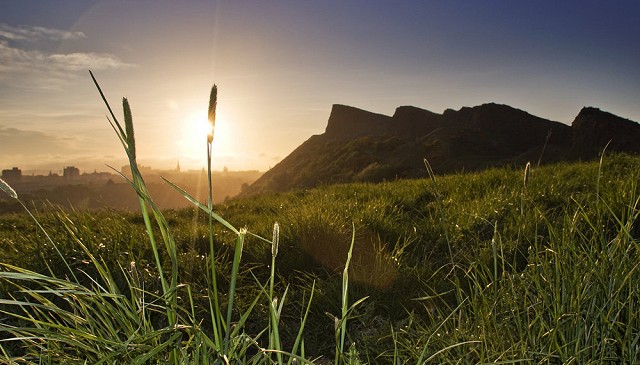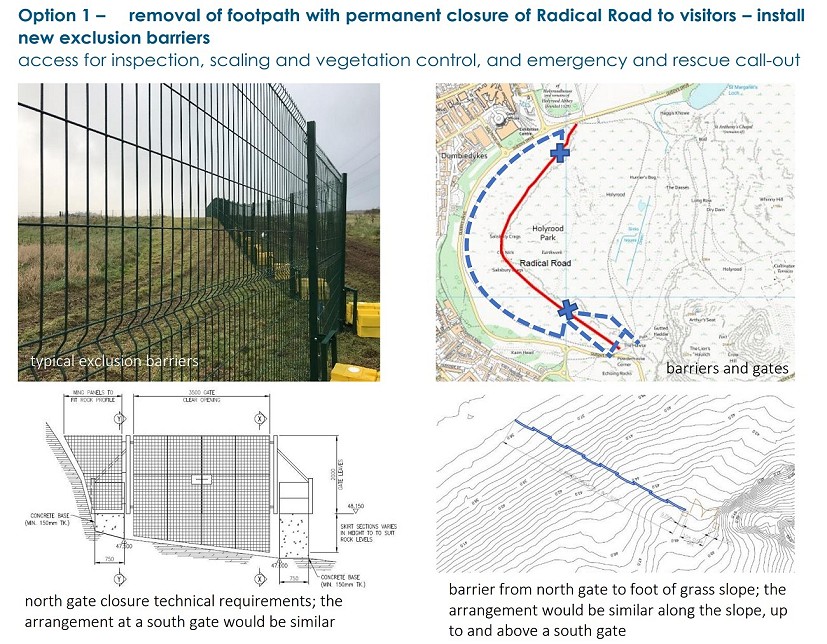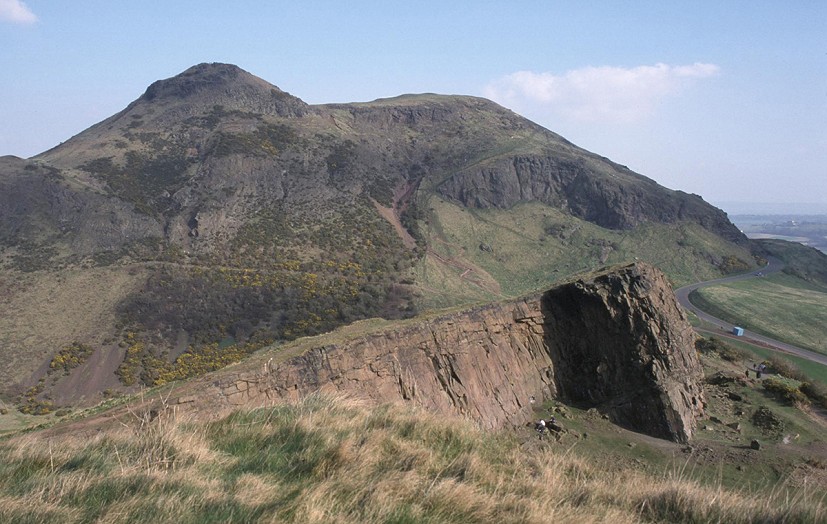Edinburgh's Radical Road and Salisbury Crags - Permanent Ban Considered
A proposal to permanently close the Radical Road, the path that runs beneath Salisbury Crags in Edinburgh's Holyrood Park, has been met with concern by walkers' and climbers' groups. Can a solution be found that satisfies everyone?
The path along the base of the crags was sealed off following a large rockfall in 2018, and temporary barriers have since been replaced with high wire fences and locked gates. According to an internal report obtained by investigative news site The Ferret, Historic Environment Scotland (HES), the Scottish Government agency that runs the park, are considering a number of options for the site, and it seems the front runner may be to close it for good.
With a spectacular view over the city, the 1.25km footpath has been enjoyed by the public since it was built 200 years ago. Indefinite closure would not only affect walkers and runners, but prevent access to the South Quarry, in former times a valued city centre bouldering venue in an area starved of decent rock.
The initial closure of the path in 2018 was a safety measure after an estimated 50 tons of rock fell off the crags. Though no one was injured, the incident was classed as a 'near miss' in health and safety terms. Rockfall, from small stones to massive failures, continues to be a concern.
HES feels it has a legal duty to ensure dangers to staff and members of the public are minimised where practicable, and the organisation's 'risk management options appraisal' puts forward the option of permanent closure of the crag base as the course of action with the lowest risk, and the lowest associated cost.
The HES document speculates that climate changes affecting eastern Scotland, such as more intense periods of rainfall and milder winters, may be contributing to increased rockfall activity on Salisbury Crags. This is monitored by a programme of annual inspections. HES seem to feel that the increased frequency and greater size of rockfall events [not quantified in the report], together with a growing number of visitors [also unquantified], has brought the issue to a head.
Risks identified from taking no action include death or injury to HES staff or members of the public, the prospect of future legal action against HES, and possible reputational damage.
"Natural rock safety management is an obligation; doing nothing is not an option" the report goes on.
Other possible mitigation measures weighed in the document include: building a covered path, or a walkway cantilevered out from the base of the cliff; containing Salisbury Crag in wire netting; or re-opening the Radical Road subject to more regular inspection and rock scaling. The higher intervention options all clearly come at a hefty cost, and would have a visual impact on the landscape. For now it seems all options remain on the table.
A spokesperson for HES told us: "We previously identified a risk of rockfall which could potentially cause death or serious injury on a section of the Radical Road and as a result were forced to restrict public access in this area.
"We continue to consult external specialist and partners on what is the most appropriate option to best remedy this situation, including discussions with relevant regulatory bodies to consider next moves in more detail.
"In the meantime, unfortunately, the area will remain closed. While it is never ideal or desirable to limit public access, and we acknowledge this area of the park has remained closed for some time now, the health and safety of our visitors and staff must always be paramount.
"We do however, have plans to start risk assessed, park ranger led educational visits to adjacent areas such as Hutton's Section and Hutton's Rock for students and educational groups over the next few months. "
The report acknowledges the chance of a hostile public reaction to a permanent closure, and predictably the prospect has indeed alarmed walkers' and climbers' groups.
Ramblers Scotland director Brendan Paddy said:
"It is sad and worrying to hear of the permanent threat to this iconic and historic path.
"We appreciate that the Radical Road's huge popularity increases the chance of accidents - but we wish to know much more detail about the true risk to walkers using this 200-year-old path.
"We would also urge decision-makers to carefully weigh any rockfall risk against the major negative impact of closure upon tourism and residents' health and happiness."
Though the parts of the Radical Road running directly under the crags are clearly subject to stonefall danger, at the south end - home of the bouldering - the rock is set well back from the path. Are climbers being penalised by an organisational unwillingness to accept a degree of nuance?
CEO of Mountaineering Scotland Stuart Younie said:
"We wrote to HES expressing our concerns about the closure of the Radical Road and access to the South Quarry for recreational climbing in November 2021 and eventually received a response in March this year."
"At this point it's still unclear whether the risks they have identified extend along the full length of the crags. We questioned the proportionality of the action they have taken and made the point that hazard of loose rock is something that climbers are aware of and that assessing personal safety is an accepted part of the sport. Salisbury Crags provide a unique venue for climbers based in and around Edinburgh and it's extremely disappointing that HES have taken this action without any consultation with the local access forum or the climbing community."

Elsewhere in Scotland, free public access is enshrined in law; however Holyrood Park is a rare exception in being subject to specific byelaws that give HES power to dictate access in a way that other landowners could not.
The issue has highlighted an interesting dissonance between notions of personal responsibility integral to hillwalking and climbing, and a culture focused on risk mitigation and organisational liability in an agency more usually associated with the management of historic buildings. While natural processes are largely allowed to run their course on hills and crags, Holyrood Park is a more closely managed urban space. But its rocky topography does make it rather different to the average city park, with a number of crags, and the steep summit of Arthur's Seat.
As site user tlouth7 points out on a UKC forum thread:
"[T]here are plenty of other hazards that they [HES] clearly accept, and which collectively result in several emergency responses per year:
- unfenced top edge of the crags
- highly polished, slippery summit of Arthur's Seat
- steep, unmade paths throughout the park
So they must have some appetite for risk beyond what you might see in typical urban parks."
Local climber and guidebook writer Topher Dagg, co-editor of the 7A Max sport climbing guidebook, and lead on the forthcoming new SMC Lowland Outcrops guide, takes a dim view of the proposed closure:
"As a climber, climbing author, and also as a wider lover of wild high places, the Salisbury Crags have a unique and iconic place in Scotland" he said.
"After waiting patiently for five years while access was blocked, a threatened permanent closure or sanitisation of the area would be a dangerous and depressing precedent.
"The Crags are historically significant as practically the birthplace of modern Scottish rock climbing (outwith the more privileged realms of Mountaineering), and continued to be host to the cutting edge of climbing techniques throughout the previous century. More recently they have transformed into one of the most popular and accessible urban training venues, within walking distance of the city centre, and safely enjoyed by generations of local and visiting climbers of all abilities.
"Permanent restriction of access, involving barriers and gates 'across all routes above and below the crags' would not only be impossible without significant visual degradation of the scenic park, and spoiling the attractive image of the UNESCO city as a whole, but would set a very disturbing precedent.
"What of other popular scenic locations that might hold some non-zero risk? Might all paths leading up Arthur's Seat (or Ben Nevis) be next to be closed to all visitors, the path to the Fairy Pools on Skye be paved and fenced, or countless miles of our coastline be fenced-off and gated? These would of course be the 'safest and cheapest' solution to avoiding risk to the public, and I'm sure that nobody would dare to suggest these as realistic strategies (nor would they be legal, for the most part). But the barring of access, within our very home town, sends a dangerous and draconian message that such places are to be feared and avoided.
"There is a very real need in modern life for rugged wild locations, where, with clear appreciation of the risks this may always hold, we can step off the tarmac pavement and appreciate the raw beauty of geology, erosion and the ecology of ancient steep places. For myself the crags have for many years been a place of peace and solace within the city and stresses of life. I can honestly credit evenings climbing at the Crags, as the sun sinks down into distant mountains, as having a measurable positive impact on my mental health during hard times.
"I can only hope that full and proper public consultation will be carried out in the very near future, where perhaps some acceptable compromise solutions might be given serious consideration alongside the positive value of re-opening the path to the public."
- We asked Historic Environment Scotland a number of questions about the proposals. They have yet to respond with comments on these questions.




